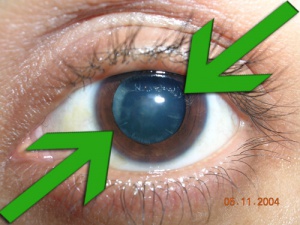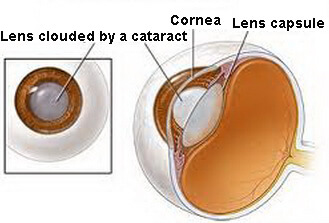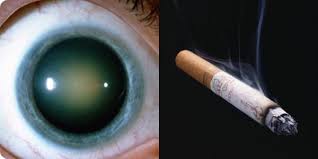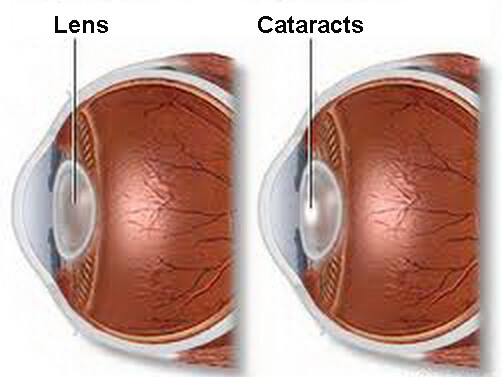How Prevent Cataracts Naturally


Written and verified by the doctor Nelton Abdon Ramos Rojas
Cataracts are almost an endemic problem of the twenty-first century due to many different factors. These include aging, many nutritional and physical factors, and abusing devices with reflective screens like cell phones, computers, tablets, etc. These all negatively affect the vision organs of both young and old. In this article we’ll look at how we can try to prevent cataracts from forming.
What are cataracts?
Main vision loss happens because your lens becomes opaque. This means that the magnifying glass that you have in your eye loses its transparency and starts to become cloudy. This happens more and more until it finally becomes like a “curtain” that prevents images from getting to your retina. It’s as if the lens of your video camera suddenly becomes dirty because of residue accumulation and is unable to capture the images.
Cataracts are a degenerative and painless vision process. Their most noticeable sign is the physical appearance of the eyes. They will start to take on a milky aspect, which progressively covers the pupil. The pupil loses its black color and becomes more and more gray as the person gets older.
This happens because protein accumulates within the lens. This creates the veil that covers the light that goes towards the retina.

This happens little by little, and can cover it completely and, in the most severe cases, can cause blindness. This disease tends to affect almost half the people that are over 65 years old.
When surgery is needed
In the case of very severe cataracts, surgery may be necessary. But, in many cases, this treatment doesn’t necessarily mean vision improvement. If that is the case, then consult your ophthalmologist to get a personalized perspective on how to improve your condition.
But there are options that you can try before resorting to surgery. With the methods we explain below, you can help to prevent cataracts, or at least halt their formation. But if this doesn’t happen, you should obviously see your ophthalmologist.
The key to these methods lies in the lens being composed of 75% water and proteins. The distribution of proteins is what interferes in the way you see light. We can define some treatments and conduct norms that will help correct these deficiencies.
You will also have to keep in mind that the probability of developing cataracts is greater in diabetics and women. There is an even higher risk if you have relatives with the disease. There is also more risk in people that have used corticoids in high dosages (up to 15 mg a day) for years, and also in smokers.

Dietary guidelines for cataract prevention
- Your diet should be rich in vitamins A and C, which are essential for tissues, eye functions, and help stop lens deterioration. In order to get vitamin A, eat “red” vegetables and fruits, carrots, oranges, papaya, etc. as well as spinach. Spinach is especially recommended to reduce the possibility of developing serious cataracts. In order to get vitamin C, there is a variety of products, like spirulina algae or moringa (leaves or oil).
- Eliminate sugary drinks and sugar in general from your diet to help to prevent cataracts. This weakens and degenerates your nervous system. For the same reason, avoid consuming caffeine and alcohol.
- You should include foods that are a natural source of antioxidants. These are oranges, lemons, grapefruit, strawberries, purple grapes, broccoli, tomatoes, olive oil, and moringa oil. Antioxidants fight free radicals (unstable oxygen molecules) that can accumulate in the eyes and cause cataracts.
- A diet rich in Omega-3 fatty acids. You can take them as a supplement or in fish (especially blue) or with linseed, chia, or oils. According to different studies, eating tuna once a week reduces the risk of cataracts up to 12%.
- Eye mucus should not get dehydrated. Drink a lot of water, at least two liters a day. You should also avoid very salty or seasoned food.
- Your liver is very related to your vision. It is important to keep it very healthy.
See also: Find Out How to Improve Your Health by Drinking More Water Every Day
Recommendations to help to prevent cataracts
Your behavior and attitude towards life is very important to help to prevent cataracts. Keep the following in mind:
- Periodic eye exams for adults. Go to the eye doctor every two years
- Protect your eyes from UV rays. Wear sun glasses and/or a hat
- Avoid being exposed to UVA rays in tanning beds. Solar ultraviolet rays (UVB) are less harmful
- Use an eye mask to sleep if you don’t have a dark room to sleep in. The pineal gland produces melatonin (the hormone that delays aging) during sleep, but only in darkness
- Don’t smoke
- Control diabetes
- Practice “eye relaxation”. Do this for a half hour by looking at calming nature scenes
Read more: Reasons to Quit Smoking and Strategies for Success
Natural medicine says that that cataracts are caused by a poor diet and diseases that cause tension in the eye muscles. This is because cataracts are more common in diabetics and smokers and don’t affect all of the elderly population. All of this makes the lens lack blood and nutrient irrigation. To help to prevent cataracts, a proper diet with many nutrients and exercise is ideal to help fight muscle tension.
Popular remedies
- Honey is a known ally to help to prevent cataracts. Apply pure honey (unrefined) to your eye. It is antibiotic and helps clean it and its nutrition
- Put an anise infusion or raw potato infusion on your eyelids everyday for an hour
- A cayenne or euphrasia infusion a day can slow down the development of the disease
- Filtered sea salt eye drops. This can irritate you at first, but it does not damage them and you can do it everyday
- A couple of drops of lemon diluted in serum or pure water. It may burn if your eyes are dirty or you have conjunctivitis, but it is very curative and does not damage the eye
- Castor oil. Wet your finger and apply it gently to the edge of your eye so that it penetrates it on its own. Moringa oil also works, but it will burn a little bit more because of its antibiotic properties. Apply it for at least a month. You can also apply linseed oil or cod oil, a drop a night.
- Aloe vera. Apply two or three drops of the blended pulp
- Pieces of cold onion. Put it in the refrigerator for a half hour and put it on your eyelids for five minutes
- Boil chamomile (1 oz), elderberry (1 oz), a potato, half a cucumber, and linseed (0.6 oz) in a liter of water. Apply compresses to your eyes.
All cited sources were thoroughly reviewed by our team to ensure their quality, reliability, currency, and validity. The bibliography of this article was considered reliable and of academic or scientific accuracy.
- Lam, D., Rao, S. K., Ratra, V., Liu, Y., Mitchell, P., King, J., Chang, D. F. (2015). Cataract. Nature Reviews Disease Primers. https://doi.org/10.1038/nrdp.2015.14.
- Mathew, M. C., Ervin, A.-M., Tao, J., & Davis, R. M. (2012). Antioxidant vitamin supplementation for preventing and slowing the progression of age-related cataract. In Cochrane Database of Systematic Reviews. https://doi.org/10.1002/14651858.CD004567.pub2
- Pollreisz, A., & Schmidt-Erfurth, U. (2010). Diabetic Cataract—Pathogenesis, Epidemiology and Treatment. Journal of Ophthalmology. https://doi.org/10.1155/2010/608751
- VIT P, JACOB T. (2008). Putative anticatarat propiertes of honeys studied by the actions of flavonoids on a lens culture models. J. Health Sc. 54(2): 196-202.
This text is provided for informational purposes only and does not replace consultation with a professional. If in doubt, consult your specialist.









